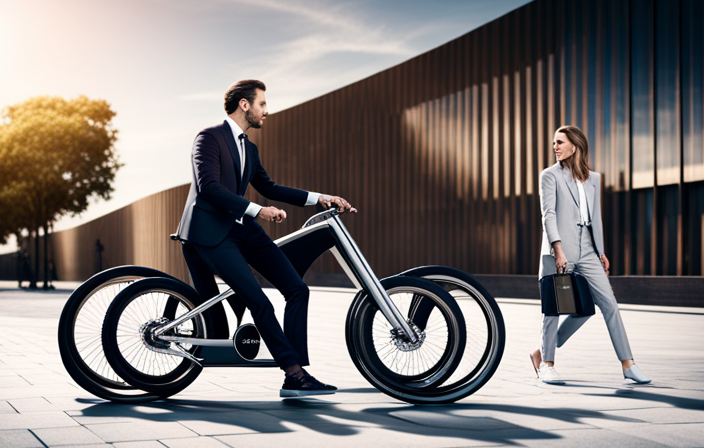As an avid electric bike rider, I am constantly amazed by the effortless power and convenience these machines offer.
But have you ever wondered how these bikes actually charge? Prepare to be blown away by the technical wizardry behind it all.
In this article, I will delve into the intricate process of how an electric bike charges, from the connection to the power source to the battery charging process itself.
Get ready to unlock the secrets and discover the future of electric bike charging.
Key Takeaways
- Electric bikes can be charged by being connected to a power source, and compatibility between the bike and power source is important.
- Different types of electric bike batteries, such as lithium-ion, nickel-metal hydride, and lead-acid, have varying pros and cons in terms of weight, lifespan, and cost.
- Battery capacity, measured in watt-hours (Wh), determines the range of an electric bike, with higher capacity batteries providing longer distances per charge.
- It is important to use the correct charging port and cables recommended by the manufacturer, as well as ensuring that the charging port and cables are in good condition for a secure connection.
Power Source Connection
The electric bike charges when it’s connected to a power source. To ensure compatibility between the bike and the power source, it is important to consider the voltage and current requirements specified by the manufacturer.
Using a power source that does not meet these requirements can result in inefficient charging or even damage to the battery.
Additionally, optimizing the charging time is crucial for a smooth riding experience. Some electric bikes come with fast-charging capabilities, allowing the battery to be fully charged in a shorter period. However, it is important to note that charging time may vary depending on the battery capacity and the power source used.
Understanding the battery and its charging requirements is essential for maintaining optimal performance and prolonging its lifespan.
Understanding the Battery
When it comes to electric bike batteries, there are several types to consider. The most common types include lithium-ion, nickel-metal hydride, and lead-acid batteries. Each type has its own set of pros and cons in terms of factors such as weight, lifespan, and cost.
Additionally, battery capacity plays a crucial role in determining the range of an electric bike. Higher capacity batteries can provide longer distances per charge, while lower capacity batteries may require more frequent recharging.
It’s important to understand these key points before selecting an electric bike battery to ensure optimal performance and range.
Types of Electric Bike Batteries
There are different types of electric bike batteries available on the market. When it comes to battery maintenance, it is essential to understand the options.
The most common types include lead-acid, nickel-metal hydride (NiMH), and lithium-ion (Li-ion) batteries. Lead-acid batteries are inexpensive but require regular maintenance, such as checking the water levels and cleaning terminals.
NiMH batteries have a higher energy density and longer lifespan, making them a popular choice. Li-ion batteries, on the other hand, are lightweight, have a high energy density, and require minimal maintenance.
It is important to consider the charging infrastructure available for each type of battery. Li-ion batteries, for example, can be charged using standard household outlets, while lead-acid batteries may require specialized charging equipment.
Understanding the different types of batteries and their charging requirements is crucial for maximizing the performance and lifespan of your electric bike.
Now, let’s delve into the next section and explore battery capacity and range.
Battery Capacity and Range
To maximize your electric bike’s performance and range, you should consider the battery capacity and how far it can take you. The battery capacity is measured in watt-hours (Wh) and determines the amount of energy your bike can store. A higher capacity battery will allow you to travel longer distances without needing to recharge.
It is important to maintain your battery properly to ensure its longevity and performance. Regularly check for any signs of damage or wear, and keep it clean and dry. Additionally, reducing the charging time can be beneficial when you’re in a hurry. To do this, you can invest in a fast charger or use a higher voltage charger, if compatible with your battery.
By optimizing your battery’s capacity and maintaining it properly, you can extend its lifespan and enjoy longer rides.
Now, let’s delve into the battery charging process.
Battery Charging Process
The battery charges by connecting it to a power source. To ensure compatibility, it is crucial to use the correct power source specified by the manufacturer. Typically, electric bikes can be charged using a standard electrical outlet commonly found in households. However, some high-performance models may require higher voltage charging stations.
The charging time estimation depends on several factors, including the battery capacity, charging voltage, and current. On average, it takes around 4 to 6 hours to fully charge an electric bike battery. However, it is important to consult the user manual or manufacturer’s guidelines for accurate charging time estimates.
Now, let’s move on to the next section, where we will discuss the charging port and cables used in the charging process.
Charging Port and Cables
Make sure you use the correct charging port and cables recommended by the manufacturer for optimal charging of your battery. Using the wrong charging equipment can lead to slower charging times or even damage to your battery.
The charging port is where you connect the power supply to the battery. It is usually located on the frame or handlebars of the electric bike.
The charging cable is the cord that connects the charging port to the power source. It is important to use a cable that matches the charging port to ensure a secure connection. Additionally, using a cable that is too long or too short can affect the charging time.
Now that we understand the importance of the correct charging port and cables, let’s move on to the safety precautions when charging your electric bike.
Safety Precautions
Using the wrong charging equipment can result in slower charging times or potential damage to your battery, so it’s important to take safety precautions. When it comes to battery maintenance and charging safety, there are a few key things to keep in mind.
First, always use the charger that is specifically designed for your electric bike. Using a charger with the wrong voltage or current can be dangerous for your battery.
Second, make sure the charging port and cables are in good condition, without any visible damage or wear.
Lastly, always charge your battery in a well-ventilated area, away from flammable materials.
Taking these precautions will help ensure the longevity and safety of your battery.
Now, let’s move on to monitoring battery health to keep your electric bike running smoothly.
Monitoring Battery Health
When it comes to maintaining optimal battery performance for electric bikes, one important aspect to consider is the battery management system (BMS).
The BMS is responsible for monitoring and controlling various parameters of the battery, such as voltage, temperature, and state of charge.
Battery Management Systems
To ensure optimal performance and longevity of your electric bike’s battery, you should regularly monitor its charge levels and implement an efficient Battery Management System (BMS).
The BMS plays a crucial role in power management and charging efficiency. It monitors the battery’s voltage, temperature, and current flow to ensure safe and efficient charging. By constantly analyzing and controlling these parameters, the BMS prevents overcharging, which can degrade the battery’s capacity over time, and undercharging, which can lead to premature failure.
Additionally, it balances the charge levels across individual cells, ensuring uniform performance and maximizing the overall capacity of the battery pack. By implementing a reliable BMS, you can optimize charging efficiency and extend the lifespan of your electric bike’s battery.
Maintaining optimal battery performance requires more than just monitoring and managing the charging process.
Maintaining Optimal Battery Performance
To maintain optimal battery performance, it’s important to regularly monitor the battery’s charge levels and implement an efficient Battery Management System (BMS).
A BMS helps in power saving and extends the battery life by ensuring that the battery is charged within its recommended voltage range and protected from overcharging or discharging.
It also helps in maintaining balanced cell voltages and prevents individual cells from becoming overcharged or undercharged.
Additionally, a BMS provides important information about the battery’s health and performance, allowing for timely maintenance and replacement if needed.
By implementing a comprehensive battery maintenance plan, you can maximize the performance and longevity of your electric bike’s battery, ensuring that it delivers optimal power when you need it.
Now, let’s explore the process of charging an electric bike at home.
Charging at Home
You can easily charge your electric bike at home by plugging it into a standard electrical outlet. Before you start charging, it’s important to ensure that your power outlet is compatible with your bike’s charger.
Most electric bikes come with a charger that is designed to work with standard 120-volt outlets. However, some higher-end models may require a 240-volt outlet.
To estimate the charging time, you can refer to the battery capacity and the charger’s output power. For example, if your bike has a 500-watt-hour battery and your charger outputs 100 watts, it would take approximately 5 hours to fully charge the battery.
Charging your electric bike at home is convenient and allows you to keep your battery topped up for your next ride.
Now, let’s move on to the next section about charging on the go.
Charging on the Go
Now that we have covered the process of charging an electric bike at home, let’s delve into the topic of charging on the go.
When you’re out and about, it’s important to have efficient and portable charging solutions to keep your electric bike powered up. Charging efficiency plays a crucial role in ensuring that you can quickly charge your bike while minimizing energy loss.
Portable charging solutions, such as compact chargers or power banks, are designed to be lightweight and easy to carry, allowing you to charge your bike wherever you are. These portable solutions often come with multiple charging ports and fast charging capabilities, ensuring that you can conveniently charge your electric bike while on the move.
Now, let’s explore the next step in the charging process: solar charging.
Solar Charging
When it comes to harnessing renewable energy, there are several key points to consider.
First and foremost, the benefits of using renewable energy sources such as solar power are immense. Not only does it help reduce our dependence on fossil fuels, but it also helps combat climate change by reducing greenhouse gas emissions.
However, it is important to acknowledge the limitations of renewable energy, such as the intermittent nature of solar and wind power, which can pose challenges for consistent energy production.
Harnessing Renewable Energy
To charge your electric bike, simply connect it to a renewable energy source such as solar panels or wind turbines. Renewable energy integration is a key aspect of innovative charging technologies for electric bikes. By harnessing the power of the sun or wind, we can charge our bikes in an environmentally friendly and sustainable way. This not only reduces our carbon footprint but also promotes the use of clean energy for transportation. To illustrate the importance of renewable energy integration, let’s consider the following table:
| Benefits | Limitations |
|---|---|
| Reduces greenhouse gas emissions | Initial setup cost may be high |
| Utilizes sustainable energy sources | Availability of renewable energy may vary |
| Promotes a greener and cleaner environment | Limited charging options in certain areas |
Benefits and Limitations
By utilizing renewable energy sources, we can reduce greenhouse gas emissions and promote a greener environment. Electric bikes are an excellent example of how we can harness this power efficiency.
These bikes have a built-in battery pack that stores electricity, which powers the motor. When the battery runs low, it needs to be recharged. The charging time for an electric bike can vary depending on the battery capacity and the charger used. On average, it takes around 4 to 6 hours to fully charge a depleted battery. However, some advanced chargers can charge the battery in as little as 2 hours. It is important to note that the charging time can also be affected by the battery’s state of charge and the charging infrastructure available.
Now, let’s explore the battery lifespan and replacement for electric bikes.
Battery Lifespan and Replacement
You should consider the battery lifespan and replacement when using an electric bike. Proper battery maintenance is crucial to extending its lifespan and ensuring optimal performance. Here are three key factors to keep in mind:
-
Charging habits: Avoid overcharging the battery, as this can lead to decreased capacity over time. It’s best to unplug the charger once the battery is fully charged. Additionally, it’s recommended to charge the battery at regular intervals, even if you haven’t fully depleted it.
-
Temperature management: Extreme temperatures can impact battery performance. Avoid exposing the battery to excessive heat or cold, as this can cause irreversible damage. Store the bike in a cool, dry place when not in use.
-
Regular inspections: Check the battery regularly for any signs of damage, such as leaks or corrosion. If you notice any issues, it’s important to address them promptly to prevent further damage.
By following these guidelines, you can maximize the lifespan of your electric bike’s battery.
Now, let’s move on to troubleshooting common charging issues without delay.
Troubleshooting Common Charging Issues
If your electric bike’s battery is not charging properly, here are a few troubleshooting steps you can take. First, check the charging cables for any signs of damage or wear. Faulty cables can prevent the proper flow of electricity, leading to charging issues. Make sure the cables are securely connected to both the bike and the power source. Next, monitor the battery temperature during charging. Overheating can indicate a problem with the battery or the charger. If the battery feels excessively hot, disconnect it from the charger and let it cool down before attempting to charge it again. Additionally, refer to the table below for common charging issues and their possible causes:
| Charging Issue | Possible Cause | Solution |
|---|---|---|
| Slow charging | Faulty charging cables | Replace charging cables |
| Battery not | Loose connection between battery and | Check and tighten the connection |
| charging | charger | |
| Battery | Overheating of battery or charger | Disconnect and let battery cool down |
| overheating | before charging again |
Environmental Impact of Electric Bike Charging
Now that we have discussed troubleshooting common charging issues, let’s explore the environmental impact of electric bike charging.
As an electric bike enthusiast, I am passionate about reducing carbon emissions and promoting sustainable transportation. Electric bikes offer a cleaner and greener alternative to traditional vehicles, but it is important to consider how their charging process fits into the larger sustainability picture.
Here are three key points to keep in mind:
-
Energy Source: The source of electricity used to charge your electric bike can have a significant impact on its environmental footprint. Opting for renewable energy sources such as solar or wind power can greatly reduce carbon emissions.
-
Charging Efficiency: Ensuring that your electric bike charger is energy-efficient can minimize wastage and further reduce your carbon footprint. Look for chargers with high efficiency ratings and consider using smart charging technology to optimize energy usage.
-
Battery Recycling: Proper disposal and recycling of electric bike batteries is crucial for reducing environmental impact. When it’s time to replace your battery, make sure to recycle it at a certified e-waste recycling facility to prevent harmful chemicals from entering the environment.
Transition: Now that we have explored the environmental impact of electric bike charging, let’s delve into future developments in electric bike charging technology.
Future Developments in Electric Bike Charging
As we look into the future, there will be exciting advancements in the technology used to charge electric bikes. One of the most promising developments is power grid integration, which allows electric bikes to draw power directly from the electrical grid. This eliminates the need for separate charging stations and makes it more convenient for riders to charge their bikes wherever there is an electrical outlet.
Another exciting advancement is wireless charging, which enables electric bikes to charge simply by being parked on a specially designed charging pad. This eliminates the hassle of plugging in the bike and reduces wear and tear on the charging port.
With these advancements, the future of electric bike charging looks promising, making it easier and more convenient for riders to keep their bikes powered up.
Transitioning to the subsequent section about ‘tips for maximizing battery life,’ it is important to understand how these advancements in charging technology can be complemented by proper battery management.
Tips for Maximizing Battery Life
To get the most out of your battery, remember to properly maintain and manage its usage. Extending battery life is crucial for maximizing the performance and longevity of your electric bike.
One of the best charging practices is to avoid letting your battery completely drain before recharging it. Instead, try to keep it between 20% and 80% charge for optimal results. Additionally, avoid exposing your battery to extreme temperatures, as this can negatively impact its performance and lifespan.
When charging, use the charger provided by the manufacturer and avoid using fast chargers, as they can generate excess heat and potentially damage the battery. Lastly, it is recommended to avoid storing your battery for extended periods of time without charging it.
By following these tips, you can ensure that your battery lasts longer and provides reliable power for your electric bike.
Transitioning into the next section, it is clear that proper charging practices are essential for maintaining the health and performance of your electric bike battery. However, as technology continues to advance, new developments are being made to further improve the charging process and make it more convenient for electric bike users.
In the next section, we will explore the future of electric bike charging and discuss the exciting possibilities that lie ahead.
Conclusion: The Future of Electric Bike Charging
In the future, advancements in charging technology will revolutionize the way we power our electric bikes. With the growing popularity of electric bikes, there is a need for more efficient and convenient charging solutions. The development of innovative charging infrastructure will play a crucial role in meeting this demand. From wireless charging pads embedded in bike lanes to fast-charging stations strategically placed in urban areas, these future innovations will make charging your electric bike as easy as charging your smartphone.
To give you an idea of what the future holds, here’s a table showcasing some potential advancements in electric bike charging technology:
| Advancement | Description | Benefits |
|---|---|---|
| Solar-powered charging ports | Charging stations that harness solar energy | Environmentally friendly, available in remote areas |
| Swappable battery systems | Easily replaceable batteries for quick charging | No waiting, increased range |
| Inductive charging technology | Wireless charging through magnetic fields | Convenient, eliminates the need for cables |
With these future innovations, the charging infrastructure for electric bikes will become more accessible, efficient, and sustainable. We can look forward to a future where charging our electric bikes is as seamless as riding them.
Frequently Asked Questions
Are electric bikes more expensive to charge than traditional bikes?
Electric bikes are more expensive to charge compared to traditional bikes. The electric bike charging cost is higher due to the energy required to charge the battery, which is not needed for traditional bikes.
Can I charge my electric bike using a regular wall outlet?
Yes, you can charge your electric bike using a regular wall outlet. However, it is recommended to use a dedicated charger for faster and more efficient charging. Alternative charging options include solar panels or portable power banks.
How long does it take to fully charge an electric bike battery?
The charging speed of an electric bike battery depends on several factors, such as the battery capacity, charger output, and charging method. It typically takes around 3-6 hours to fully charge an electric bike battery.
Can I overcharge my electric bike battery?
Yes, you can overcharge your electric bike battery, which can lead to risks such as reduced battery lifespan and potential damage to the battery cells. It is important to follow the manufacturer’s recommended charging guidelines to avoid overcharging.
Can I charge my electric bike battery with a portable power bank?
"Better safe than sorry." Yes, you can charge your electric bike battery with a portable power bank. However, it is important to ensure compatibility between the power bank and your electric bike’s charging options.
Conclusion
In conclusion, the future of electric bike charging looks bright and promising.
With advancements in technology, we can expect more efficient and convenient ways to charge our bikes. As the demand for electric bikes continues to rise, manufacturers will focus on developing faster charging systems and longer-lasting batteries.
Picture a world where electric bike charging stations are as common as gas stations, allowing riders to easily and quickly power up their bikes.
The future is electric, and with it comes a new era of sustainable transportation.









